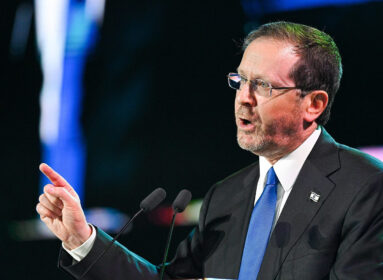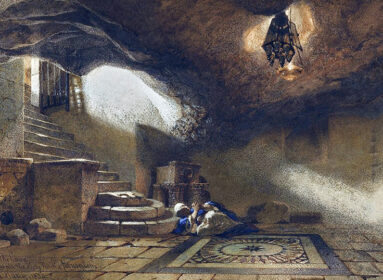
In America, a Jewish refugee from czarist Russia became a major modernist painter
By Cindy Mindell
NORWALK – In 1915, 10-year-old Chassid Maurice Golubov set out from Vetka, Russia with his mother and five younger siblings for New York, where his father had immigrated several years prior. Somewhere along the Trans-Siberian Railway between Moscow and the port of Vladivostok and back again, the young boy was separated from his family. After several months roaming with a band of children who survived by raiding small farms, Golubov eventually found his mother and siblings in Saint Petersburg, and the family sailed for New York after a long journey to Oslo in 1917.
Golubov left behind the Chassidic community where he had studied Hebrew, Yiddish, Talmud, and Jewish mysticism as part of his early training for the rabbinate. But his childhood experiences between Vetka and New York would come to infuse a vibrant career as a notable abstract and figurative painter of the mid-20th-century American art world.
Golubov died in 1987 at age 82. His son, Michael, will recount the artist’s remarkable life on Sunday, April 30 at Temple Shalom in Norwalk. An exhibit of works, “Maurice Golubov – Journey to the Infinite,” runs at the synagogue from April 16 through May 28.
Artistic from age six, Golubov requested and received a box of art supplies and drawing pad as a bar mitzvah gift. He stumbled into his first art class with famed painter John Sloan at a Hebrew Educational Society settlement house in Brooklyn, drawing from nature, figures, and his own memory. At age 15, he dropped out of school to apprentice in a Manhattan fashion studio, where he copied figure illustrations, and enrolled in painting classes at the National Academy of Design (now the National Academy Museum and School). In 1922, the academy honored him with the Suydam Silver Medal for excellence in life drawing.
As a teenager, Golubov developed a fascination for philosophy, continuing his study of medieval Jewish mysticism along with Spinoza, Schopenhauer, Kant, Fichte, Berkeley, and Emerson, as well as Eastern philosophy. He also loved poetry, reading everything from Greek poetry to Shakespeare’s sonnets to Emily Dickinson as inspiration for his work. These inquiries would provide a basis for Golubov’s original theory of the “fourth-dimensional figure.” In an autobiographical essay written years later, the artist explained, “I could sense and feel more closely the things I felt were real and yet unseen. I didn’t feel comfortable trying to express these in words, however; instead, I started to find symbolic means to be able to represent them pictorially.”
In addition to figural painting, Golubov began to experiment with abstract designs in his painting, including variations on the shapes of Hebrew letters. Throughout his career, he would fund his painting and study with commercial art commissions, painting full-time when funds allowed.
In 1933, he married Springfield, Mass. native Sylvia Glasser, a Juilliard School-trained pianist, and the couple began to split their time between Manhattan and various summer homes in Massachusetts and New York state. Their only child, Michael, was born in New York in 1943.
The younger Golubov recalls a childhood home filled with Jewish culture.
“My mother’s great-grandfather was a major rabbi in Lithuania; my parents really didn’t practice Judaism and only attended a temple at certain times,” he says. “But they were very social. We would have evenings where my father would read Sholem Aleichem stories in Yiddish and my mother would play the piano and my father would pass around his works in miniature.”
Over the course of his career, Maurice Golubov created thousands of works. His summertime oil paintings were frequently figurative, while winters in New York produced abstract canvases with loose grid structures, dark colors, and expressionist surfaces.
Golubov began to show his work in 1941, with a solo exhibition at the Artists’ Gallery in Manhattan. Over the next four decades, his paintings would appear in New York shows with the American Abstract Artists and Federation of Modern Painters and Sculptors, and at the Jewish Museum, the Museum of Modern Art, the Whitney Museum of American Art, and the Brooklyn Museum, as well as at several galleries. His work has also been exhibited at the Newark Museum, the Museum of Fine Arts in Houston, the Walker Art Center in Minneapolis, the Smithsonian American Art Museum in Washington, D.C., and Annely Juda Fine Art in London, UK.
In the mid-‘70s, Michael began to catalog his father’s work, arranging for artistic representation with the Tibor de Nagy Gallery in Manhattan for several years. The Norwalk show is the first in the Tristate area in 40 years.
“Tibor was a major gallery dealer in New York; he exposed a lot of avant-garde artists of his day,” Michael says. “Tibor had a special feeling for the work and unfortunately, when he died, the people who took over the gallery didn’t have the same approach as Tibor and my father wasn’t exposed in New York.”
The works were brought to Detroit by a Golubov cousin, the son of major art collectors, and only returned to New York a few years ago.
A New York state resident for most of his life, Michael Golubov studied piano in the Juilliard Pre-College Division before earning an architecture degree from Columbia University. “In doing my student designs there, I was influenced by my father’s work,” he says. “I grew up with it; it’s very personal for me, and I’ve lived with some of his pieces for many years.”
In 2013, Michael spent a year in Wilton, Connecticut where he met Temple Shalom religious school teacher Gilda Simpkin. Over the last three years, the two have worked to bring an exhibit of Golubov’s paintings to the synagogue.
“A lot of my father’s approach to art was based on his experiences as a child in Russia,” Michael says. “He was training as a rabbi; his family was Orthodox. Later in life, he was religious in his own way. I was intrigued by the idea of having a show in a synagogue just for that reason. I think it’s appropriate.”
Most of the pieces selected for the exhibit have been shown in museums or major galleries. “Michael told me that he never saw his father without a pencil in his hand,” Simpkin says. “We want to expose these works to a wider audience and we hope to ultimately get them into the hands of people who will love and cherish them.”
“Maurice Golubov – Journey to the Infinite: Recollections from His Son,” Sunday, Apr. 30, 10:15 AM, Temple Shalom, 259 Richards Ave., Norwalk. “Maurice Golubov – Journey to the Infinite” is on exhibit at the synagogue from April 16 through May 28. For information: templeshalomweb.net / (203) 866-0148.
To learn more about Maurice Golubov: mauricegolubov.net.
CAP: Hebrew Letter Variations







 Southern New England Jewish Ledger
Southern New England Jewish Ledger



















